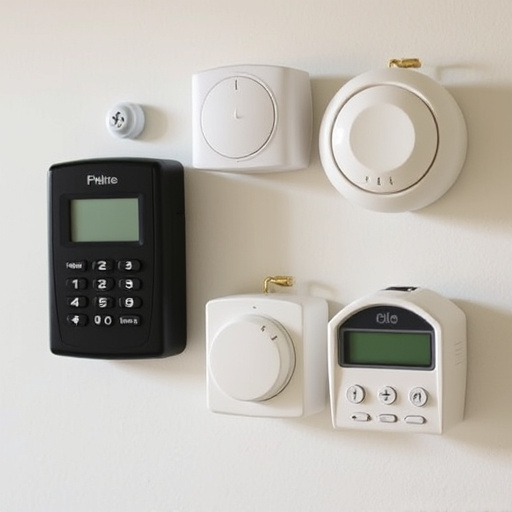Discreet wearable alarms offer advanced personal safety with compact, stylish designs that integrate powerful features into everyday accessories. These devices provide adjustable sensitivity, customizable alarm sounds, and wide coverage areas for tailored protection during various activities. Some models feature real-time tracking and distress notification systems for added peace of mind. By expanding beyond standard loud sounds, monitoring systems ensure swift assistance in distress situations, particularly beneficial for vulnerable individuals. Defining the personal alarm's sound coverage area is crucial for its effectiveness, balancing alertness with privacy. Secure data transmission and user privacy control are paramount to these innovative tools, fostering trust in their life-saving capabilities.
Discreet wearable alarms offer a revolutionary way to enhance personal safety, especially in scenarios where immediate attention is needed without drawing public notice. This article delves into the design and features of these innovative devices, exploring how monitoring enhances their effectiveness. We’ll also dissect critical aspects like sound coverage area and integration concerns, providing insights to ensure users maximize the benefits of discreet wearable alarms while maintaining privacy.
- Understanding Discreet Wearable Alarms: Design and Features
- How Monitoring Enhances Personal Alarm Safety
- Defining Sound Coverage Area: Ensuring Effective Alarming
- Integration and Privacy Considerations for Discreet Wearables
Understanding Discreet Wearable Alarms: Design and Features
Discreet wearable alarms are designed to offer personal protection with minimal visibility. These innovative devices blend advanced safety features into compact, stylish forms that can be worn as accessories. Unlike traditional alarms, they’re not bulky or obtrusive, allowing users to carry them discreetly while still enjoying peace of mind.
Key design elements include adjustable sensitivity levels for accurate activation, customizable personal alarm sounds tailored to individual preferences, and a wide coverage area ensuring protection during various activities. Some models even incorporate advanced monitoring features, such as real-time tracking and emergency notification systems, enabling wearers to seamlessly communicate their location and distress signals when needed.
How Monitoring Enhances Personal Alarm Safety
Monitoring enhances personal alarm safety by providing a crucial layer of security beyond the standard loud personal alarm sound. When equipped with monitoring capabilities, wearables can transmit alerts to designated contacts or emergency services within a specified coverage area, ensuring help arrives promptly in case of distress. This feature is particularly valuable for individuals who may be at higher risk, such as the elderly living alone or those with medical conditions requiring constant vigilance.
By integrating discrete wearable alarms with monitoring systems, users can enjoy enhanced peace of mind. The monitoring network allows for real-time tracking and response to potential hazards, whether it’s a fall, an attempted assault, or any other emergency situation. This proactive approach to safety complements the immediate impact of the personal alarm sound by facilitating quicker intervention and potentially saving lives.
Defining Sound Coverage Area: Ensuring Effective Alarming
Defining the sound coverage area is a crucial aspect of ensuring effective personal alarm functionality. This area refers to the range within which the alarm’s sound can be clearly and loudly heard, alerting the wearer and potentially deterring potential threats or intruders. It’s important to consider factors like ambient noise levels in various environments (such as bustling public spaces versus quieter residential areas) when determining this range.
Wearable alarms designed for personal safety should offer a coverage area that allows for effective alerting without causing unnecessary disturbance to bystanders. Optimizing the sound projection and intensity can help achieve this balance, ensuring the alarm’s effectiveness while minimizing potential privacy or noise-related concerns.
Integration and Privacy Considerations for Discreet Wearables
The integration of discreet wearable alarms into daily life requires careful consideration of privacy and security aspects, especially as these devices are designed to be virtually invisible. Wearables that offer personal alarm sounds must maintain a delicate balance between functionality and discreteness. The device’s ability to emit an effective yet non-intrusive alarm sound within a specific coverage area is key. This ensures the user can signal for help without attracting unwanted attention.
Privacy considerations extend beyond the alarm function. Data transmission, storage, and access need robust encryption and secure protocols to protect personal information. With continuous monitoring capabilities, wearables collect sensitive data on users’ locations, activities, and potential emergencies. Therefore, clear transparency about data usage and strict user control over privacy settings are essential to building trust in these innovative personal safety tools.
Discreet wearable alarms, with their innovative design and monitoring capabilities, offer a revolutionary approach to personal safety. By focusing on minimalism and effective sound coverage area, these devices provide peace of mind without drawing attention. Understanding the unique features and privacy considerations ensures that users can fully leverage this technology. When integrated properly, discreet wearables enhance personal alarm safety, giving individuals the confidence to navigate their surroundings with added security.
